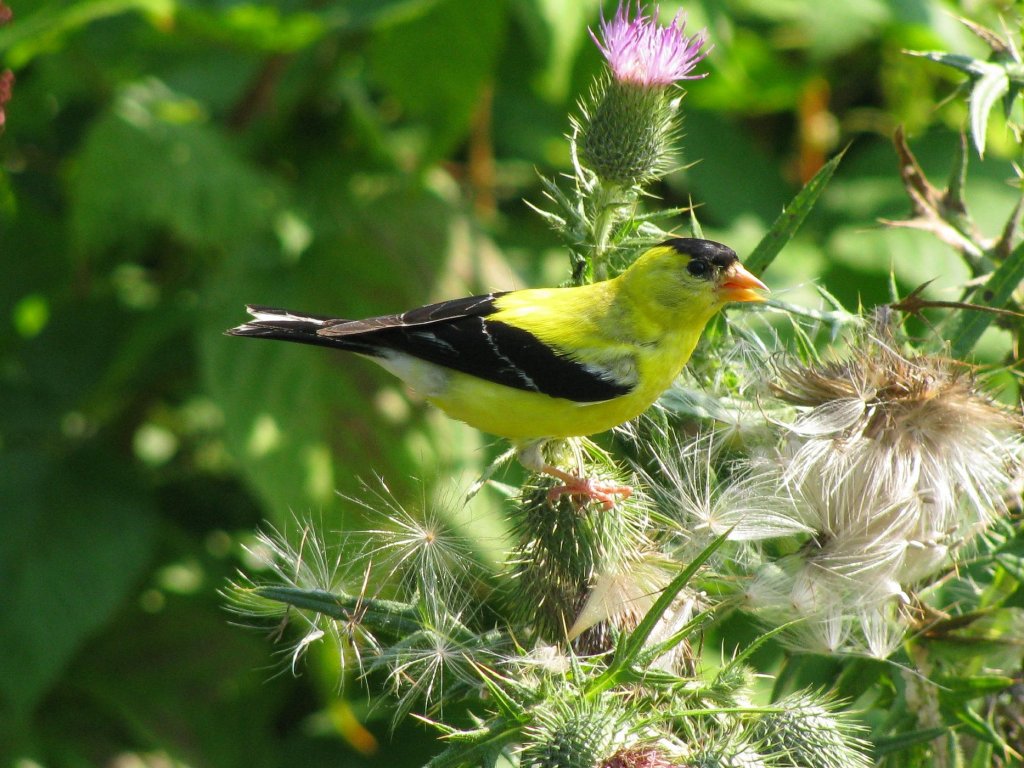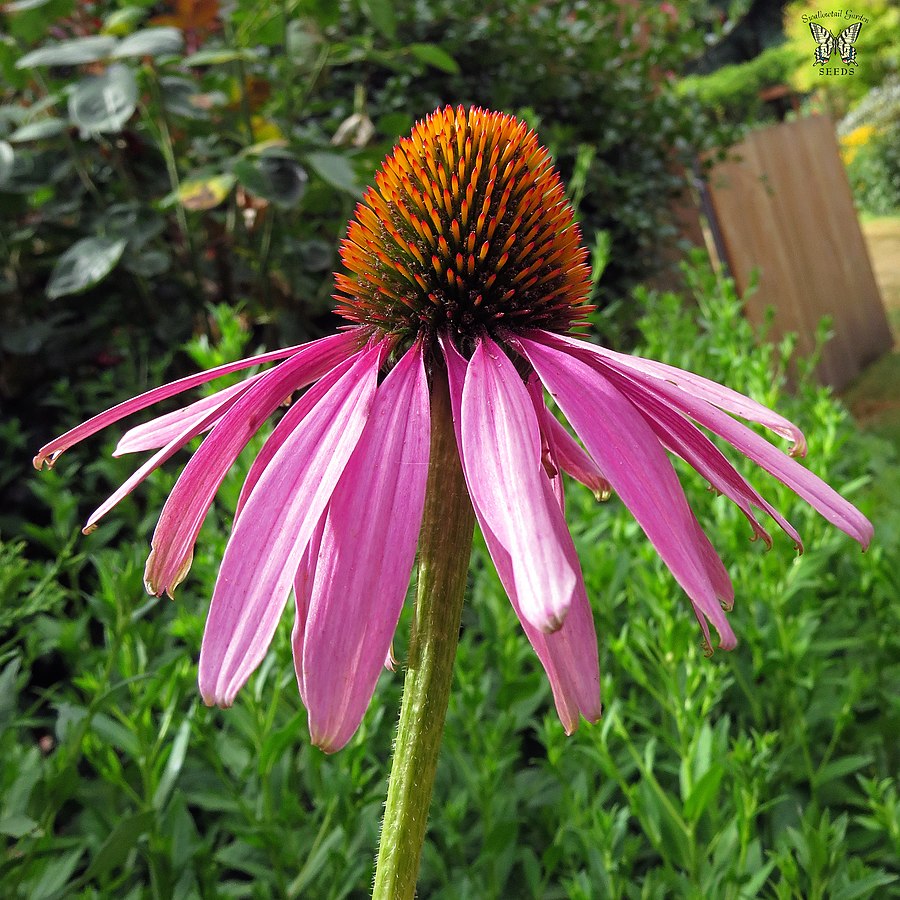Have you heard the joke that the state bird of New Jersey is dead. Being from the Garden State, I sometimes tell that one. Actually, the New Jersey state bird is the American Goldfinch (Spinus tristis), a colorful, permanent resident native to a large part of the US.


In mid-summer, when the nesting season begins to wind down for most Connecticut birds, the American Goldfinch is just getting going. It is the last of our resident birds to nest, during July and August. Nest building is timed for when thistles (Cirsium spp.) go to seed.
The female goldfinch builds a cup-shaped nest in a shrub or small tree, often out in the open rather than deep in the forest. She lines the nest with soft thistle down, sometimes so much that it can be hard to see the eggs! She chooses two or three forked branches to support the nest, usually 4 to 20 feet (about 1 to 6 meters) off the ground. You might be able to get goldfinches to nest in your yard by planting trees and shrubs, particularly if they are at the edge of a woodland. Fruit trees, Buttonbush (Cephalanthus occidentalis), Black Elderberry (Sambucus nigra), Flowering Dogwood (Benthamidia florida), and hawthorns (Crataegus spp.) are popular nest sites.
American Goldfinches are very social birds. Unlike most birds, they will not set up nesting territories or try to scare away a goldfinch flock that comes close to a nest. The female lays from 4 to 7 light blue eggs that she incubates for 12 to 14 days. The male will feed her during this time. When the eggs hatch, she will be the primary caregiver. But as the chicks grow, the male takes over more of the feeding. A female will sometimes start another brood while the male is feeding the fledglings. After 10 to 15 days the young leave the nest. They will continue to be fed nearby for a few weeks afterward.
Recently, I saw several male goldfinches in quite acrobatic positions, even hanging upside down, while eating thistle seeds. They are not picky about what kind of thistle they eat, whether native species like Field Thistle (Cirsium discolor), Swamp Thistle (Cirsium muticum), and Pasture Thistle (Cirsium pumilum), or non-native Tall Thistle (Cirsium altissima), Creeping Thistle (Cirsium arvense), and the invasive Common or Bull Thistle (Cirsium vulgare). While thistles might be their favorite food, goldfinches will eat other types of seeds too, including purple coneflower (Echinacea spp.), bee balm (Monarda spp.), asters (Symphyotrichum spp. and other genera), Dandelion (Taraxacum officinale), and sunflowers (Helianthus spp.). They also eat tree buds, maple tree (Acer spp.) sap, raspberries (Rubus spp.), and more.

Although most passerines (the perching birds) feed their young insects, like caterpillars and other easily munchable packets of protein and fats, goldfinches are mostly vegetarian. Parents will regurgitate thistle and other seeds for their chicks, and sometimes include insects like aphids. Vegetarian goldfinches are a problem for the Brown-headed Cowbird (Molothrus ater), which sometimes lay its eggs in goldfinch nests. Cowbird chicks need a diet of insects and so usually die within two or three days of hatching.

I love to listen to a flock of goldfinches singing in my yard. The male’s song is a several-second series of twills and warbles that is very canary-like. The flight pattern of both males and females is easy to spot—they swoop up and down as they fly. Both males and females make a “po-ta-to-chip” or “per-chicory” call when they fly.
Did you know that a flock of goldfinches is called a charm? These spunky, acrobatic, social birds with canary-like songs definitely are charming, and a joy to have around.
Delightful! Wonderful to learn about these native birds. We recently moved to northeastern Connecticut from the northern CA Bay Area, where we had tons of lesser goldfinches. These tiny birds were so small that when they perched on a long dandelion stem to eat its seeds, they did not bend the stem!
LikeLike
Yes, they are quite acrobatic! Thanks for your comment. Best, Jim
LikeLiked by 1 person
We have a “charm” of goldfinches all year long in and around our yard. We have a thistle seed feeder that they empty on a regular basis. They also use the sunflower seed feeder too. And the bird bath. And look quite nice in our tomato plants! I am glad to know when the breeding season is and will see if I can notice any nests.
LikeLike
That’s great Ellen. Best regards, Jim
LikeLike
Thanks Jim, always well thought out and educational blogs!!
My Mom-in-law lived near a marsh and I am amazed at the number of finches around her home.
LikeLike
Thanks so much Barb and thx for leaving a comment! All best, Jim
LikeLike
Nice article. Just love these guys. So, I have a thistle feeder, loads of Monarda, some coneflowers, sunflowers, raspberries, too. Just haven’t seen a Goldfinch in Spring Glen in ages; saw one early June.
LikeLike
Thank you for explaining how it is that they feed seeds to the nestlings. And is it because they nest so late in the season that they only have one brood?
I have loved these birds. I think their song is so sweet.
LikeLike
Hi Beverly, They will usually have only one brood per year. I’ve read that veteran females may produce an additional brood, but she’ll leave her original mate to care for the first brood and while she finds a partner for the second nesting. Thx, Jim
LikeLike
Thank you, Jim, for a wonderful article about the goldfinch! It is very interesting to find out that they nest in summer, after most of the other birds are done with their nesting season! Also, a fascinating factoid about how goldfinches feed their young regurgitated thistle and other seeds. There are 4-6 goldfinches in my garden, feasting on coneflower and bee-balm seed heads! I don’t see a lot of thistles where I live, and I thought it might be nice to add some to our meadow for the goldfinches. Do you have a recommendation for which species to plant in a medium soil, sunny area, and if any local nurseries carry them? Thanks! Linda
LikeLike
Hey Linda, Sorry just saw that I didn’t respond to your comment! And thank you for it! There are 3 native thistles I would recommend in CT: Cirsium discolor – Field Thistle, C. muticum – Swamp Thistle, and C. muticum – Pasture thistle. I haven’t seen them for sale around here. They should be as they are top pollinator plants too. Unfortunately because of some introduced and highly invasive thistles, they have been given a “bad rap.” I’ve heard that thistles can hybridize easily too. If you hear of any nurseries selling them, please let me know. Thx!
LikeLike
Hi Jim, Thanks for your response! I was searching Prairie Moon Nursery (Winona, MN) and they do carry both Pasture thistle and Swamp thistle seeds and 3-packs of potted plants! The 3-packs are sold out–presumably will be re-introduced next spring for the new growing season. I think next year I will get a 3-pack of Pasture thistle to plant!
LikeLike
Hi Linda,
Ah – should have mentioned Prairie Moon. I have ordered seeds from them before. If they are sold out – looks like they are popular plants!
LikeLike